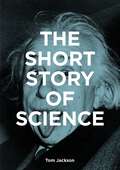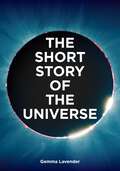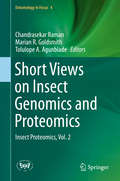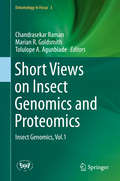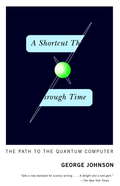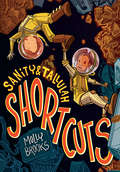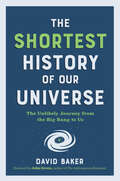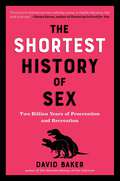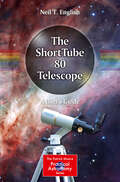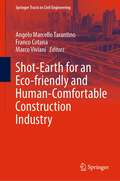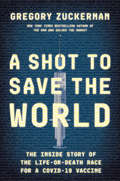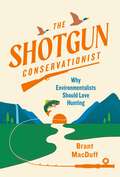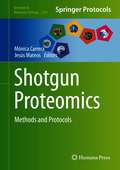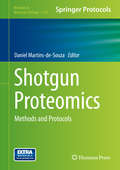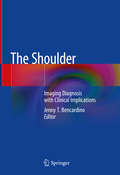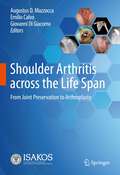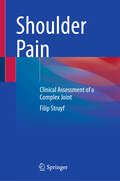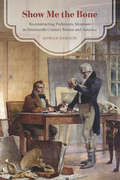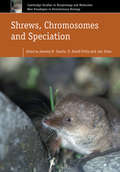- Table View
- List View
A Short Story of Chemistry
by Isaac AsimovExamines the development of the basic principles of chemistry from the Bronze Age to the present day
The Short Story of Science: A Pocket Guide to Key Histories, Experiments, Theories, Instruments and Methods
by Tom Jackson Mark Fletcher'Nothing in life is to be feared. It is only to be understood. Now is the time to understand more, so that we may fear less' Marie CurieThe Short Story of Science is a new introduction to the complete subject of science. Covering 60 key experiments, from Archimedes' investigations of buoyancy to the discovery of dark matter, and then linking these to the history of science, as well as to the key theories and methods, the book simplifies and explains all the key breakthroughs.Accessible and concise, generously illustrated throughout, and with all the essential information presented without jargon, readers are given all the tools they need to enjoy the fascinating history of scientific knowledge.
The Short Story of Science: A Pocket Guide to Key Histories, Experiments, Theories, Instruments and Methods
by Tom Jackson Mark Fletcher'Nothing in life is to be feared. It is only to be understood. Now is the time to understand more, so that we may fear less' Marie CurieThe Short Story of Science is a new introduction to the complete subject of science. Covering 60 key experiments, from Archimedes' investigations of buoyancy to the discovery of dark matter, and then linking these to the history of science, as well as to the key theories and methods, the book simplifies and explains all the key breakthroughs.Accessible and concise, generously illustrated throughout, and with all the essential information presented without jargon, readers are given all the tools they need to enjoy the fascinating history of scientific knowledge.
The Short Story of the Universe: A Pocket Guide to the History, Structure, Theories and Building Blocks of the Cosmos
by Gemma Lavender Mark FletcherThe Short Story of the Universe is a new introduction to the subject of the universe. Covering 130 key components that make it up - from dwarf galaxies and spiral arms to red giants and the planets of the solar sytem - and linking these to the universe's structure and the theories that help us understand it, this book simplifies this riveting yet mind-boggling subject, telling the story of how it came into being and how it will eventually be no more. Accessible and concise, generously illustrated throughout, and with all the essential information presented without jargon, readers are given all the tools they need to enjoy the fascinating history of the deepest depths of the universe.
The Short Story of the Universe: A Pocket Guide to the History, Structure, Theories and Building Blocks of the Cosmos
by Gemma Lavender Mark FletcherThe Short Story of the Universe is a new introduction to the subject of the universe. Covering 130 key components that make it up - from dwarf galaxies and spiral arms to red giants and the planets of the solar sytem - and linking these to the universe's structure and the theories that help us understand it, this book simplifies this riveting yet mind-boggling subject, telling the story of how it came into being and how it will eventually be no more. Accessible and concise, generously illustrated throughout, and with all the essential information presented without jargon, readers are given all the tools they need to enjoy the fascinating history of the deepest depths of the universe.
Short Views on Insect Genomics and Proteomics
by Chandrasekar Raman Marian R. Goldsmith Tolulope A. AgunbiadeEntomology as a science of inter-depended branches like molecular entomology, insect biotechnology, has made rapid progress. This also implies that there is an urgent need to manage the available resources. In the past five decades, entomology has taken giant steps ahead. The aim of this work is to integrate perspectives across molecular and biochemistry, physiology, reproduction, developmental biology, molecular evolution, genetics and RNAi applications. This century is proclaimed as the Era of Biotechnology and it consists of all types of Mol-Bio-Gen applications, which is an essential component for a thorough understanding of the insect biology. The aim of this work is to provide the comprehensive review of recent research from various geographic areas around the world and contributing authors that are recognized experts in their respective field of Genomic entomology. This Volume emphasizes upon the need for and relevance of studying molecular aspects of entomology in Universities, Agricultural Universities and other centers of molecular research. It will also serve as a landmark source for Insect advance science technology.
Short Views on Insect Genomics and Proteomics
by Chandrasekar Raman Marian R. Goldsmith Tolulope A. AgunbiadeEntomology as a science of inter-depended branches like molecular entomology, insect biotechnology, has made rapid progress. This also implies that there is an urgent need to manage the available resources. In the past five decades, entomology has taken giant steps ahead. The aim of this work is to integrate perspectives across molecular and biochemistry, physiology, reproduction, developmental biology, molecular evolution, genetics and RNAi applications. This century is proclaimed as the Era of Biotechnology and it consists of all types of Mol-Bio-Gen applications, which is an essential component for a thorough understanding of the insect biology. The aim of this work is to provide the comprehensive review of recent research from various geographic areas around the world and contributing authors that are recognized experts in their respective field of Genomic entomology. This Volume emphasizes upon the need for and relevance of studying molecular aspects of entomology in Universities, Agricultural Universities and other centers of molecular research. It will also serve as a landmark source for Insect advance science technology.
A Shortcut Through Time
by George JohnsonThe newest Pentium chip powering PCs and laptops contains 40 million electronic switches packed onto a piece of silicon about the size of a thumbnail. Several years from now, if this incredible shrinking continues, a single chip will hold a billion switches, then a trillion. The logical culmination is a computer in which the switches are so tiny that each consists of an individual atom. At that point something miraculous happens: Quantum mechanics kick in. Anyone who follows the science news or watches 'Star Trek' has at least a notion of what that means: particles can be in two or more places at once. Atoms obey a peculiar logic of their own - and if it can be harnessed society will be transformed. Problems that would now take forever would be solved almost instantly. Quantum computing promises nothing less than a shortcut through time.
Shortcuts (Sanity & Tallulah #3)
by Molly BrooksEverything is up in the air when the problem-solving best friends Sanity and Tallulah find themselves co-pilots on an unplanned adventure filled with action, adventure, and dangerous situations.Tallulah is great at piloting! And with her learner's permit freshly reinstated, she has the perfect opportunity to prove it: filling in on the mail route to nearby stations while all the regular pilots are out sick. It's her first big solo flight, and yeah, okay, her parking could use some work, but she's not even a little bit nervous—she's got Sanity along as copilot, plenty of old flight logs for navigation, and they'll be in radio contact with Wilnick almost the whole time. All they have to do is follow the pre-approved route and stay out of the dangerous, uncharted, explosives-littered debris cloud . . . no matter how tempting a shortcut it is. Oh, and don't cross the military blockade into the United Territories, obviously. See? No sweat!Sanity and Tallulah's pre-approved route didn't say anything about space stations exploding, enemies in need of rescue, or getting caught in the middle of a border crisis in danger of escalating into all-out war, but sometimes totally awesome pilots have to change plans on the fly, and only an excellent copilot can keep things from going completely upside down.
The Shortest History of Our Universe: The Unlikely Journey From The Big Bang To Us (Shortest History #0)
by David BakerA complete history of the universe, spanning 13.8 billion years in an ultra-accessible, uncommonly illuminating, exhilarating chronicle of key events “Baker introduces us not only to the history of our species and our planet, but the history of our vast universe.”—from the foreword by John Green, author of The Anthropocene Reviewed and The Fault in Our Stars In this thrilling history, David Baker captures the longest-possible time span—from the Big Bang to the present day—in an astonishingly concise retelling. His impressive timeline includes the “rise of complexity” in the cosmos and the creation of the first atoms; the origin of all galaxies, stars, and our solar system; and the evolution of life on Earth, from tiny single-celled organisms to human beings. Weaving together insights across the sciences—including chemistry, physics, biology, archaeology, and anthropology—Baker answers the fundamental questions: How did time begin? Why does matter exist? What made life on Earth the way it is? He also argues that never before has life on Earth been forced to adjust to a changing climate so rapidly, nor has one species ever been responsible for such sudden change. Baker’s grand view offers the clearest picture of what may come next—and the role we can still play in our planet’s fate.
The Shortest History of Sex: Two Billion Years Of Procreation And Recreation (Shortest History #0)
by David BakerA wild—and satisfying!—ride through two billion years of sexual evolution. The Shortest History books deliver thousands of years of history in one riveting, fast-paced read. From the first microbial exchanges of DNA to Tinder and sexbots, how did sex begin, and how did it evolve to be so varied and complex in humans? What influence do our genetic ancestors have on our current love lives? And what might sex look like in the future? With acuity, humor, and respect for human diversity, The Shortest History of Sex reveals where the many facets of our sexuality—chemical, anatomical, behavioral, social—come from. Chasing down our evolutionary family tree, from the first aquatic creatures to primate societies, David Baker sheds light on our baffling array of passions, impulses, and fetishes, and guides us toward a clear understanding of one of the deepest, most abiding forces of human nature. The Shortest History of Sex also charts how sex changed for humans across the foraging, agrarian, and modern eras, showing how, even as our biology and sexual instincts have remained the same, the current nature of our sex lives has no historical or evolutionary precedent. The result is a revealing, utterly unique insight into history and human behavior—and the profound forces of nature and nurture compelling our most intimate relationships.
The ShortTube 80 Telescope: A User's Guide (The Patrick Moore Practical Astronomy Series)
by Neil T. EnglishWelcome to the first comprehensive guide to one of the world’s most popular telescopes: the ShortTube 80 refractor. With its ultra-portability, versatility, and relatively low cost, this telescope continues to delight generations of stargazers.Starting in the field under a dark sky, the author walks the reader through a typical evening of stargazing, where the ShortTube 80 brings many astronomical treasures into focus. From there, he provides an in–depth account of the optical properties of the ShortTube 80 refractor and the accessories and mounting arrangements that maximize its potential both as a spotting ‘scope by day and an astronomical ‘scope by night.The main text discusses how the versatile ShortTube 80 can be used to study deep sky objects, the Sun, the Moon, bright planets and even high-resolution projects, where the instrument's features can be optimized for the observation of tight double and multiple stars. It explores how the ShortTube 80 can image targets using camera phones, DSLRs and dedicated astronomical CCD imagers.Packed with practical advice gained from years of firsthand stargazing experience, this book demonstrates exactly why ShortTube 80 has remained a firm favorite among amateur astronomers for over three decades, and why it is likely to remain popular for many years to come.
Shot-Earth for an Eco-friendly and Human-Comfortable Construction Industry (Springer Tracts in Civil Engineering)
by Angelo Marcello Tarantino Franco Cotana Marco VivianiThis book presents an innovative and environmentally friendly type of excavated earth-based building material, called Shot-Earth. The use of a common excavated earth as a construction material (both for structural and non-structural applications) has many important advantages, the main one being that the soil can be used as a zero kilo and zero cost material, being used in the same place where it is excavated. This volume collects the main results obtained by the research units in the FIRS2019-00245 research project, funded by the Italian Ministry of Research (MUR) and dedicated to the study of Shot-Earth materials. Many of the exposed contributions concern the optimization of the mixture and application technique, which consists in the application of the mixture sprayed on a support (that serves as formwork), with or without reinforcements, by using a pressure pipe (that is by a high-speed projection). This new construction technique allows to quickly realise a variety of structural systems, even with a complex geometry (like vaults, arches, shells, tunnel coatings, underground tanks, waterproofing of walls for landfills and waste storages, slope stabilization, etc.). An additional feature of Shot-Earth is that it can be used to realise high energy-efficient buildings. In particular, this innovative technology can improve the capacity of a building to auto-regulate its interior heat and humidity, increasing indoor environment quality and energy performance and reducing building gas emissions.
A Shot to Save the World: The Inside Story of the Life-or-Death Race for a COVID-19 Vaccine
by Gregory Zuckerman"An inspiring and informative page-turner." –Walter IsaacsonLonglisted for the FT/McKinsey Business Book of the Year Award The authoritative account of the race to produce the vaccines that are saving us all, from the #1 New York Times bestselling author of The Man Who Solved the MarketFew were ready when a mysterious respiratory illness emerged in Wuhan, China in January 2020. Politicians, government officials, business leaders, and public-health professionals were unprepared for the most devastating pandemic in a century. Many of the world&’s biggest drug and vaccine makers were slow to react or couldn&’t muster an effective response. It was up to a small group of unlikely and untested scientists and executives to save civilization. A French businessman dismissed by many as a fabulist. A Turkish immigrant with little virus experience. A quirky Midwesterner obsessed with insect cells. A Boston scientist employing questionable techniques. A British scientist despised by his peers. Far from the limelight, each had spent years developing innovative vaccine approaches. Their work was met with skepticism and scorn. By 2020, these individuals had little proof of progress. Yet they and their colleagues wanted to be the ones to stop the virus holding the world hostage. They scrambled to turn their life&’s work into life-saving vaccines in a matter of months, each gunning to make the big breakthrough—and to beat each other for the glory that a vaccine guaranteed. A #1 New York Times bestselling author and award-winning Wall Street Journal investigative journalist lauded for his &“bravura storytelling&” (Gary Shteyngart) and &“first-rate&” reporting (The New York Times), Zuckerman takes us inside the top-secret laboratories, corporate clashes, and high-stakes government negotiations that led to effective shots. Deeply reported and endlessly gripping, this is a dazzling, blow-by-blow chronicle of the most consequential scientific breakthrough of our time. It&’s a story of courage, genius, and heroism. It&’s also a tale of heated rivalries, unbridled ambitions, crippling insecurities, and unexpected drama. A Shot to Save the World is the story of how science saved the world.
The Shotgun Conservationist: Why Environmentalists Should Love Hunting
by Brant MacDuffAt the intersection of hunting and conservation, a man shares his personal journey from staunch anti-hunter to compassionate, ethical hunter, weaving together a larger history of humans, animals, the environment, and our food systems.The Shotgun Conservationist doesn&’t teach us how to hunt, it explores why we should hunt. As public lands remain imperiled, factory farms pollute the earth and subject animals to inhumane conditions, and global uncertainty presses us all to be more self-sufficient, there has never been a better time to take up hunting. Writer, natural historian, and public speaker Brant MacDuff has done just that. An avid animal lover and raised as a non-hunter, MacDuff started his journey intending to investigate the claim that &“hunting is conservation.&” So convinced, he now holds a hunting license in four states and gives lectures on the positive impact it has on conservation efforts nationwide. Armed with years of experience in the field and a deep love for the natural world, MacDuff tells the provocative, humorous, and insightful story of how he became a hunter. Along the way, readers meet a cast of colorful characters and learn the firsthand research that helped change Brant&’s mind. You may not book a hunting trip after reading The Shotgun Conservationist, but you&’ll have a new perspective on and appreciation for those that do.
Shotgun Proteomics: Methods and Protocols (Methods in Molecular Biology #2259)
by Mónica Carrera Jesús MateosThis edition details a collection of specific shotgun proteomics-based laboratory techniques and applications developed in leading laboratories and proteomics units worldwide. Chapters cover a broad range of topics covering, shotgun proteomics of extracellular vesicles and subcellular structures, shotgun proteomics in non-model organisms, clinical proteomics, food proteomics, analysis of post-translational modifications and protein complexes, and data processing and storage. Written in the highly successful Methods in Molecular Biology series format, chapters include introductions to their respective topics, lists of the necessary materials and reagents, step-by-step, readily reproducible laboratory protocols, and tips on troubleshooting and avoiding known pitfalls. Authoritative and cutting-edge, Shotgun Proteomics: Methods and Protocols aims to be an up-to-date guide for researchers seeking to understand the proteome of any given biological sample.
Shotgun Proteomics
by Daniel Martins-de-SouzaShotgun Proteomics: Methods and Protocols serves as a vital collection of protocols through which thousands of proteins can be simultaneously identified, quantified and characterized in a high throughput manner. Beginning with the history of proteomics centered on the vital role of mass spectrometry in its development, this detailed volume continues with chapters on sample pre-fractionation, in vivo and in vitro stable isotope labeling, label-free proteomics, informatics, protein-protein interactions, targeted proteomics and post-translational modifications. Written for the highly successful Methods in Molecular Biology series, chapters include introductions to their respective topics, lists of the necessary materials and reagents, step-by-step, readily reproducible laboratory protocols and tips on troubleshooting and avoiding known pitfalls. Practical and comprehensive, Shotgun Proteomics: Methods and Protocols is an ideal and up-to-date guide for researchers seeking to understand the proteome of any given species.
The Shoulder: Imaging Diagnosis with Clinical Implications (The\clinics: Radiology Ser. #20-2)
by Jenny T. BencardinoThis book covers all aspects of imaging diagnosis of shoulder disorders from a clinical perspective. After discussion of relevant imaging techniques, a wide spectrum of disorders is addressed in a series of dedicated chapters on rotator cuff injuries and impingement syndromes, biceps tendon and rotator interval pathology, glenohumeral instability, SLAP tears and microinstability, shoulder girdle fractures, shoulder arthropathies, tumors and tumor-like conditions, and entrapment neuropathies. Separate consideration is also given to the pediatric shoulder and to preoperative planning, postoperative imaging, and surgical techniques in patients undergoing shoulder arthroplasty.The unique anatomy and range of motion of the shoulder joint can present a diagnostic challenge. Characterization of soft tissue injuries and radiographically occult osseous pathology is often facilitated by the use of advanced imaging techniques, including MRI, CT, and ultrasound. Readers will find this excellently illustrated book to be an invaluable aid to diagnostic interpretation when employing these techniques.
Shoulder Arthritis across the Life Span: From Joint Preservation to Arthroplasty
by Augustus D. Mazzocca Emilio Calvo Giovanni Di GiacomoThis book comprehensively covers the diagnosis, classification, assessment, and management of shoulder arthritis, a condition with increasing incidence that affects people of all ages. In a multidisciplinary format, it discusses imaging, laboratory testing, nutrition, surgery and rehabilitation.The first part of the book covers conservative treatments, followed by various minimally invasive treatments and specific techniques in the second part. The subsequent parts of the book focus on joint replacement, including alternative options to traditional arthroplasty. Each part is further divided by age group, addressing specific considerations unique to each population. The final part explores new technologies applied to shoulder arthroplasty. Published in collaboration with ISAKOS, this book provides a thorough discussion on how to prevent failure, diagnose, and manage shoulder arthritis in patients of all ages. Written by leading international shoulder experts, it is an essential resource for shoulder surgeons, rehabilitators, and other healthcare practitioners.
Shoulder Pain: Clinical Assessment of a Complex Joint
by Filip StruyfIn this book, Professor Filip Struyf explores the epidemiology of shoulder pain and provides a concise explanation of shoulder anatomy, helping healthcare providers understand how this complex joint functions. He discusses various approaches to problem-solving in shoulder pain and offers an overview of questionnaires, patient-reported outcome measures (PROMs), and patient-reported experience measures (PREMs) used to assess pain, function, and the psychosocial experience of patients. The book also addresses important topics such as screening for red flags and the initial contact with the patient. It provides insights into effective communication strategies and teaches how to build a good relationship with individuals suffering from shoulder pain. Readers will immerse themselves in the clinical assessment of patients with shoulder complaints, including visual inspection, palpation, and comprehensive movement examinations. The book covers various typical shoulder conditions, such as rotator cuff-related shoulder pain, biceps tendon and labral disorders, rotator cuff tears, frozen shoulder, glenohumeral instability, neurological shoulder pain, and much more. Additionally, it offers insights into the role of imaging in diagnosing various shoulder conditions. In summary, this is an essential reference for healthcare professionals interested in shoulder pain.
Show and Tell! Great Graphs and Smart Charts: An Introduction to Infographics
by Stuart J. MurphyA visual-learning expert races up the charts and graphs math success with kid-friendly content sure to help with homework.Want to find the most popular meal in the cafeteria? Compare town sports enrollments? Or maybe you just want to know who burps the most in your family! Learn what line graphs, bar graphs, pie charts, and pictographs are and how and when to use them to represent data. Each project shows how to build a chart or graph and ties it all together with a creative infographic that really puts the A in STEAM (Science, Technology, Engineering, ARTS, and Mathematics). Whether used as an introductory aid or to underscore previous knowledge, the book prepares today's visually savvy children to succeed in school and life by analyzing the world around them.
Show Me the Bone: Reconstructing Prehistoric Monsters in Nineteenth-Century Britain and America
by Gowan DawsonNineteenth-century paleontologists boasted that, shown a single bone, they could identify or even reconstruct the extinct creature it came from with infallible certainty--"Show me the bone, and I will describe the animal!" Paleontologists such as Georges Cuvier and Richard Owen were heralded as scientific virtuosos, sometimes even veritable wizards, capable of resurrecting the denizens of an ancient past from a mere glance at a fragmentary bone. Such extraordinary feats of predictive reasoning relied on the law of correlation, which proposed that each element of an animal corresponds mutually with each of the others, so that a carnivorous tooth must be accompanied by a certain kind of jawbone, neck, stomach, limbs, and feet. Show Me the Bone tells the story of the rise and fall of this famous claim, tracing its fortunes from Europe to America and showing how it persisted in popular science and literature and shaped the practices of paleontologists long after the method on which it was based had been refuted. In so doing, Gowan Dawson reveals how decisively the practices of the scientific elite were--and still are--shaped by their interactions with the general public.
Showing Time: In Memory of Alberto Argenton
by Ian F. Verstegen Laura Messina-Argenton Tiziano Agostini Tamara PrestHow does a visual artist manage to narrate a story, which has a sequential and therefore temporal progression, using a static medium consisting solely of spatial sign elements and, what is more, in a single image? This is the question on which this work is based, posed by its designer, Alberto Argenton, to whose memory it is dedicated. The first explanation usually given by scholars in the field is that the artist solves the problem by depicting the same character in a number of scenes, thus giving indirect evidence of events taking place at different times. This book shows that artists, in addition to the repetition of characters, devise other spatial perceptual-representational strategies for organising the episodes that constitute a story and, therefore, showing time. Resorting to the psychology of art of a Gestalt matrix, the book offers ha formattato: Italiano (Italia) Codice campo modificato ha formattato: Italiano (Italia) ha formattato: Italiano (Italia) researchers, graduates, advanced undergraduates, and professionals a description of a large continuous pictorial narrative repertoire (1000 works) and an in-depth analysis of the perceptual-representational strategies employed by artists from the 6th to the 17th century in a group of 100 works narrating the story of Adam and Eve.
Showstopper!: The Breakneck Race to Create Windows NT and the Next Generation at Microsoft
by G. Pascal ZacharyThis &“inside account captures the energy—and the madness—of the software giant&’s race to develop a critical new program. . . . Gripping&” (Fortune Magazine).Showstopper is the dramatic, inside story of the creation of Windows NT, told by Wall Street Journal reporter G. Pascal Zachary. Driven by the legendary David Cutler, a picked band of software engineers sacrifices almost everything in their lives to build a new, stable, operating system aimed at giving Microsoft a platform for growth through the next decade of development in the computing business. Comparable in many ways to the Pulitzer Prize–winning book The Soul of a New Machine by Tracy Kidder, Showstopper gets deep inside the process of software development, the lives and motivations of coders and the pressure to succeed coupled with the drive for originality and perfection that can pull a diverse team together to create a program consisting of many hundreds of thousands of lines of code.
Shrews, Chromosomes and Speciation (Cambridge Studies in Morphology and Molecules: New Paradigms in Evolutionary Bio #6)
by Jeremy B. Searle P. David Polly Jan ZimaThe chromosome complement (karyotype) often differs between related mammalian species (including humans vs chimpanzees), such that evolutionary biologists muse whether chromosomal difference is a cause or a consequence of speciation. The common shrew is an excellent model to investigate this problem because of its many geographical races (potential species) differing chromosomally, and its several sibling species (recently speciated forms) that are also chromosomally different. This system is an exceptional opportunity to investigate the role of chromosomes in speciation and this volume reflects detailed research following these approaches. Highlights include the demonstration that chromosomal re-arrangements can be associated with complete loss of gene flow and thus speciation and that selection within species hybrid zones may lead to de-speciation rather than speciation. This book represents an extraordinarily detailed consideration of the role of chromosomes in speciation in one astonishing species, providing insights to those interested in mammalian diversity, chromosomal evolution and speciation.

